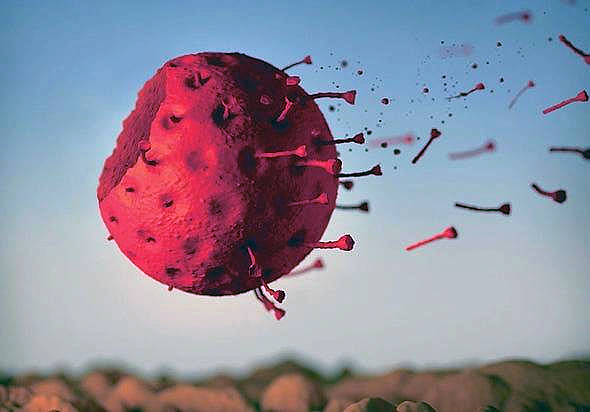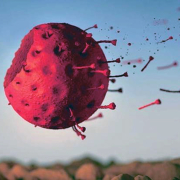COVID-19 END GAME
The VIRUS
Here is what we don’t know —
No one knows how and when the COVID-19 pandemic will end, including Donald J. Trump.
Here is what we do know —
This coronavirus is unprecedented in the combination of being easily transmitted from one person to another, and COVID-19 exhibits a wide a range of symptoms (going from none to deadly). It has disrupted a world with 21st century science and technology at its disposal, but in an environment of unprecedented global political division.
Viruses are constantly mutating. Those that trigger pandemics have enough novelty that the human immune system does not quickly recognize them as dangerous invaders.
They force the body to create a brand-new defense, involving new antibodies and other immune system components that can react to and attack the foe.
Large numbers of people get sick in the short term, and social factors such as crowding and the unavailability of medicine can drive those numbers even higher. Ultimately, in most cases, antibodies developed by the immune system to fight off the invader linger in enough of the affected population to confer longer-term immunity and limit person-to-person viral transmission. But that can take several years, and before it happens, havoc reigns.
What can we do?
Some of the world’s best scientific minds, and lesser minds in the political arena, are trying to figure out the end game of living with COVID-19, and into the foreseeable future.
The question as to how the pandemic will play out is part science, part social, and part political. The percentage of effort we give these 3 elements of COVID-19 decision making and policy will determine the degree of humanity’s success or failure in a battle to the death with this killer virus.
At best, present projections about how COVID-19 will play out are speculative. The end game will most likely involve a mix of everything that checked past pandemics:
- Continued social-control measures to buy time,
- new antiviral medications to ease symptoms, and
- the Holy Grail — a vaccine.
If any of the several antiviral medications currently in development prove effective, they will improve treatment options and lower the numbers who get seriously ill or die. A technique to screen for SARS-CoV-2 neutralizing antibodies, an indicator of immunity in recovered patients, could also prove very useful. Previously used only in local epidemics, these new serological assays won’t end the pandemic, but they could make it possible to spot and use antibody-rich blood as a treatment for critically ill patients; more certainly, the tests will also get people back to work faster if those who fought off the virus and are immune can be identified.
Unless a vaccine is administered to all of the world’s eight billion inhabitants who are not currently sick or recovered, COVID-19 is likely to become endemic. It will circulate and make people sick seasonally—sometimes very sick. It is not clear whether a vaccine will confer long-term immunity as with measles or short-term immunity as with flu shots. But “any vaccine at all would be helpful at this point,” says epidemiologist Aubree Gordon of the University of Michigan.
But if the virus stays in the human population long enough, it will start to infect children when they are young. Those cases are typically, though not always, quite mild, and so far the children appear less likely to develop severe disease if they get reinfected as adults. The combination of vaccination and natural immunity will protect many of us.
The coronavirus, like most viruses, will live on—but not as a planetary plague.
The Public, Political Reaction
As ‘quarantine fatigue’ spreads, Dr. Fauci, director of the National Institute of Allergy and Infectious Diseases, says second wave of coronavirus is ‘inevitable’ in the United States, which has recorded more than 1.3 million confirmed cases — nearly one-third of the global total.
Fauci also warned that “we could be in for a bad fall and a bad winter” if the right countermeasures aren’t put in place
A small minority of Americans are showing growing signs of “quarantine fatigue” and officials face pressure to ease coronavirus restrictions, factories, malls and state governments in many parts of the country are taking steps toward reopening.
A recent Monmouth University poll found 81% of Americans believe the outbreak measures taken by their state government have either been appropriate or not gone far enough. Therefore, protest coverage should include data showing real views of the public.
Given the size and composition of rallies’ focused on overturning public health measures designed for virus mitigation it is unsurprising that many protesters neither practiced social distancing nor wore masks as shown by the media coverage. Protesters wave signs and flags with a common theme objection to stay-at-home orders, including a mix of anti-vaccine and pro-gun rights activists, COVID-19 pandemic denialists, and conspiracy theorists.
Hawaii’s record of stay-at-home compliance has been a good one, and chiefly responsible (island-by-island) for state’s “momentary” success in mostly containing the COVID-19 outbreak.
What Can Hawaii Learn from this island prefecture?
Japan’s northern island of Hokkaido offers a grim lesson in the next phase of the battle against COVID-19. It acted quickly and contained an early outbreak of the coronavirus with a 3-week lockdown. But, when the governor lifted restrictions, a second wave of infections hit even harder. Twenty-six days later, the island was forced back into lockdown.
Hokkaido’s story is a sobering reality check for Hawaii and leaders across the world as they consider easing coronavirus lockdowns.
Experts say restrictions were lifted too quickly and too soon because of pressure from local businesses, coupled with a false sense of security in its declining infection rate.
The Japanese prefecture of 5.3 million people, known for its rugged mountain beauty and long history of farming and fishing, and was the first area of Japan to see a major coronavirus outbreak. It’s very different from Japan’s main island, Honshu, with its frenetic sprawling cities.
Hokkaido’s leaders acted early and decisively, even as the national government was criticized for moving too slowly to stop the spread elsewhere. Japan still has relatively few confirmed COVID-19 cases compared to other countries—12,400—but the numbers have more than doubled in the last two weeks.
Hokkaido doctors saw their first coronavirus patient, a tourist from Wuhan, China.
By mid-March, the health crisis was stabilizing—new cases were in the low single digits and even zero on some days—but complaints from businesses were increasing. Hokkaido’s two main industries—agriculture and tourism—had been devastated.
“Hokkaido’s business sector was opposed to the state of emergency, but the governor also wanted Hokkaido to be an example to the rest of Japan for how to control the virus,” says Aya Hasegawa, a reporter for the Hokkaido Shimbun newspaper. Three weeks after Hokkaido successfully initiated CVOID-19 containment measures, the island was re-opened for business. With the state of emergency lifted, and only residents who “feel unwell” were asked to stay at home, the rest of island engaged in limited social interactions in an attempt to find some kind of functional “normal”.
Large Japanese companies, after the state of emergency was lifted, began sending a fresh crop of workers from Tokyo and Osaka to Hokkaido. That likely seeded even more infections and soon the second outbreak was in full bloom.
By April 9—exactly three weeks after the lockdown was lifted—there was a record number of new cases: 18 in one day. “Officials thought about people coming from overseas but never considered that domestic migration could bring the virus back,” said Hironori Sasada, professor of Japanese politics at Hokkaido University.
With a second lock down now in place in Hokkaido, businesses are now preparing for the long haul. Tetsuya Fujiawara, CEO of Smile Sol, a group of ten pub restaurants in Hokkaido, says even though sales are down 60%, he’d rather a strong, consistent lockdown than “lukewarm measures” that would only perpetuate the another cycle of restrictions being lifted and then reinstated as infections surge – again.
Living With COVID-19
Looking to recent history for clues on how best to live (not die) with COVID-19, the H1N1 influenza outbreak of 1918–1919 provides some useful guidance, even 100 years later.
Doctors and public health officials had far fewer weapons than they do today, and the effectiveness of control measures such as school closures depended on how early and decisively they were implemented.
Over two years and three waves, the pandemic infected 500 million and killed between 50 million and 100 million.
It only ended as natural infections conferred immunity on those who recovered.
The H1N1 strain became endemic, an infectious disease that was constantly with us at less severe levels, circulating for another 40 years as a seasonal virus.
It took another pandemic—H2N2 in 1957—to extinguish most of the 1918 strain. One flu virus kicked out another one, essentially, and scientists don’t really know how. Human efforts to do the same have failed. “Nature can do what we cannot,” says virologist Florian Krammer of the Icahn School of Medicine at Mount Sinai in New York City.
Ultimately, in most cases, antibodies developed by the immune system to fight off the invader may linger long enough that the affected population will confer longer-term immunity to broader population and limit person-to-person viral transmission. But that can take several years, and after that happens, we will be judged by future generations on how well we succeeded or failed to address an unseen threat.



Leave a Reply
Join the Community discussion now - your email address will not be published, remains secure and confidential. Mahalo.